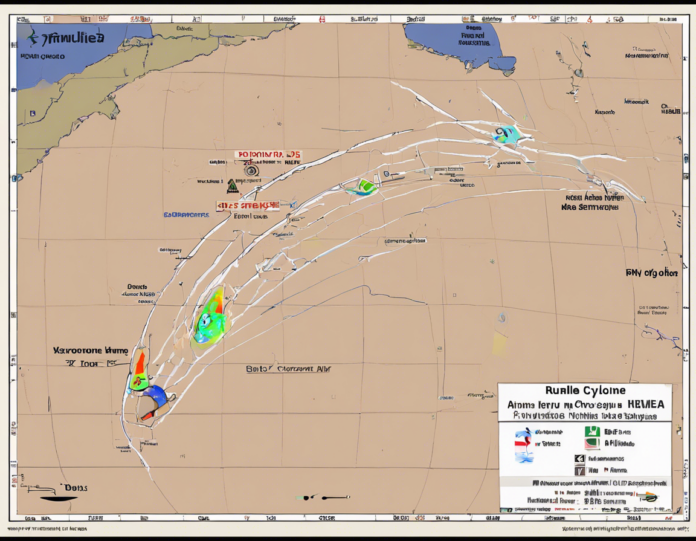The Rumela Cyclone is a natural disaster that can have devastating effects on the environment, infrastructure, and human lives. Understanding the impact of cyclones like Rumela is crucial in preparing for and mitigating its consequences. In this article, we will explore the various aspects of the Rumela Cyclone and its aftermath.
What is a Cyclone?
Before delving into the specifics of the Rumela Cyclone, it’s important to understand what a cyclone is. A cyclone is a large scale air mass that rotates around a strong center of low atmospheric pressure. Cyclones are characterized by inward spiraling winds that rotate counterclockwise in the northern hemisphere and clockwise in the southern hemisphere. These intense weather systems can cause strong winds, heavy rainfall, storm surges, and flooding.
Rumela Cyclone: A Profile
The Rumela Cyclone is named after a unique flower found in the region where it typically forms. This tropical cyclone is known for its rapid intensification and erratic path, making it particularly dangerous for coastal areas in its trajectory. Rumela Cyclone can bring destructive winds exceeding 74 mph and torrential rainfall, leading to flooding and landslides. The storm surge associated with Rumela can inundate coastal areas, causing widespread damage to property and infrastructure.
Environmental Impact of Rumela Cyclone
The environmental impact of the Rumela Cyclone can be severe and long-lasting. The strong winds and heavy rainfall can uproot trees, destroy vegetation, and disrupt ecosystems. The storm surges can erode coastlines, submerge low-lying areas, and cause saltwater intrusion into freshwater sources. The aftermath of the cyclone may include soil erosion, water contamination, and habitat destruction, posing a threat to biodiversity and ecosystem resilience.
Infrastructure Damage and Economic Losses
Rumela Cyclone can leave a trail of destruction in its wake, affecting infrastructure such as homes, buildings, roads, bridges, and power lines. The high winds and flooding can cause structural damage, power outages, and communication disruptions, hampering rescue and relief efforts. The economic losses from the cyclone can be significant, with repairs and reconstruction costing billions of dollars. The impact on agriculture, fisheries, tourism, and other industries can further compound the economic consequences of the cyclone.
Human Toll and Social Impacts
One of the most tragic aspects of the Rumela Cyclone is its impact on human lives. The strong winds, heavy rains, and storm surges can lead to casualties, injuries, and displacement of populations. The loss of homes, livelihoods, and community infrastructure can have profound social impacts, causing trauma, displacement, and societal upheaval. Vulnerable populations, such as the elderly, children, and marginalized communities, are often disproportionately affected by the cyclone’s devastation.
Preparedness and Mitigation Strategies
In light of the destructive potential of the Rumela Cyclone, it is essential for coastal communities and authorities to have robust preparedness and mitigation strategies in place. Early warning systems, evacuation plans, shelters, and emergency supplies can help reduce the risk to human life during a cyclone. Infrastructure resilience, land-use planning, ecosystem restoration, and climate adaptation measures can mitigate the environmental and economic impacts of cyclones like Rumela.
Recovery and Resilience Building
After the passage of the Rumela Cyclone, the focus shifts to recovery and resilience building. Rapid assessment of damages, restoration of essential services, livelihood support, and psychosocial assistance are essential for post-cyclone recovery. Long-term strategies for infrastructure reconstruction, ecosystem rehabilitation, community empowerment, and climate adaptation are vital for building resilience to future cyclones and climate-related disasters.
Frequently Asked Questions (FAQs)
- What is the difference between a cyclone, hurricane, and typhoon?
-
Cyclone, hurricane, and typhoon are different names for the same weather phenomenon, depending on the region where it occurs. In the Atlantic and Eastern Pacific, they are called hurricanes, while in the Northwest Pacific, they are referred to as typhoons. In the Indian Ocean and South Pacific, they are known as cyclones.
-
How are cyclones categorized?
-
Cyclones are categorized based on their wind speed using the Saffir-Simpson Hurricane Wind Scale. Categories range from 1 (weakest) to 5 (strongest), with Category 3 and above considered major hurricanes.
-
What role does climate change play in the intensity of cyclones like Rumela?
-
Climate change can lead to warmer ocean temperatures, which fuel the intensity of cyclones. Warmer oceans provide more energy for cyclones to form and intensify, leading to stronger winds and heavier rainfall.
-
How can communities prepare for a cyclone like Rumela?
-
Communities can prepare for a cyclone by creating emergency plans, securing homes and property, stocking up on essential supplies, staying informed through reliable sources, and heeding evacuation orders from authorities.
-
What are the key challenges in responding to a cyclone aftermath?
-
Key challenges in responding to a cyclone aftermath include access to affected areas, coordination among multiple agencies, provision of emergency services, distribution of aid to impacted populations, and ensuring the safety and security of responders.
-
How can individuals contribute to cyclone relief efforts?
- Individuals can contribute to cyclone relief efforts by donating to reputable organizations, volunteering time or resources, spreading awareness on social media, and advocating for policies that address climate change and disaster risk reduction.
Conclusion
The Rumela Cyclone serves as a stark reminder of the destructive power of natural disasters and the urgent need for preparedness, mitigation, and resilience building. By understanding the environmental, economic, social, and human impacts of cyclones like Rumela, we can work towards creating safer and more sustainable communities that are better equipped to withstand and recover from future disasters.
